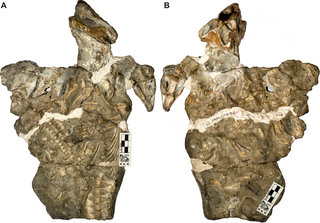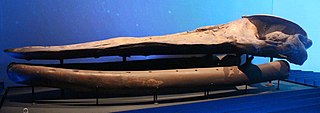Articles related to anatomy include:

Galesaurus is an extinct genus of carnivorous cynodont therapsid that lived between the Induan and the Olenekian stages of the Early Triassic in what is now South Africa. It was incorrectly classified as a dinosaur by Sir Richard Owen in 1859.
Mesocetus is an extinct genus of baleen whale from the Miocene of Europe and North America.
"Balaenoptera" ryani is an extinct species of Balaenopteridae from the late Miocene of California. It was originally considered a species of Balaenoptera, but is now recognized as more primitive than any extant or fossil balaenopterid and thus in need of a new generic name.

Mixocetus is a genus of extinct baleen whale belonging to the family Tranatocetidae. It is known only from the late Miocene (Tortonian) of Los Angeles County, California.
The Astoria Formation is a geologic formation in Washington state & Oregon. It preserves fossils dating back to the early to middle Miocene.

Otekaikea is an extinct genus of toothed whale closely related to Waipatia. It is known from the late Oligocene (Chattian) of New Zealand.
Eomysticetidae is a family of extinct mysticetes belonging to Chaeomysticeti. It is one of two families in the basal chaeomysticete clade Eomysticetoidea.

Tranatocetus is an extinct genus of mysticete from the late Miocene (Tortonian) of Jutland, Denmark. The type and only species is Tranatocetus argillarius.

Allodelphis is an extinct genus of whale belonging to Allodelphinidae found in marine deposits of the eastern North Pacific.
Allodelphinidae is a family of primitive platanistoid river dolphins found in marine deposits in the eastern North Pacific region, Alaska, and Japan.

Arktocara is an extinct genus of river dolphin from the Oligocene epoch of Alaska, containing one species, A. yakataga. Having been discovered in 25-million-year-old strata near the 60th parallel north, it is perhaps the oldest-known crown toothed whale and the northmost river dolphin discovered. It was a member of the now-extinct family Allodelphinidae, along with the genera Allodelphis, Goedertius, Ninjadelphis, and Zarhinocetus. It measured approximately 2.26 or 2.28 meters, comparable to its closest living relative, the South Asian river dolphin, which measures 2.4 meters (7.9 ft). However, the animal probably had an elongated beak and neck, so it may have been longer. The animal is known only from a partially preserved skull. Its ecology may have been similar to the modern-day Dall's porpoise, and it may have competed with contemporaneous delphinoids. Its remains were found in the Poul Creek Formation, which has also yielded several mollusk species.

Goedertius is an extinct genus of river dolphin from the early Miocene (Burdigalian) Nye Formation of Oregon.
Ninjadelphis is an extinct genus of river dolphin from the early Miocene (Burdigalian) of Japan.
Pomatodelphis is an extinct genus of river dolphin from Middle Miocene marine deposits in Alabama, Florida, Brazil, Germany and France.
Prepomatodelphis is an extinct genus of river dolphin from Early Miocene marine deposits in Austria.
Inticetus is an extinct genus of Early Miocene odontocete from the Chilcatay Formation, Pisco Basin, Peru.
Macrosqualodelphis is an extinct genus of river dolphins from the Early Miocene (Burdigalian) Chilcatay Formation of the Pisco Basin, Peru. The type species is M. ukupachai.

Pebanista is an extinct genus of platanistid "river dolphin" that lived during the Early to Middle Miocene in Peru. As a member of the Platanistidae, Pebanista is most closely related to the extant Ganges and Indus river dolphins (Platanista) of South Asia and shares no close relation to the modern Amazon river dolphin that inhabits the same region today. Like its close relatives, Pebanista possesses enlarged crests that would have covered the melon in life, possibly helping to focus their biosonar while hunting in murky waters. Pebanista further stands out as being the largest "river dolphin" yet discovered, reaching lengths between 2.8–3.47 m at minimum, much larger than the biggest recorded freshwater cetaceans of today. Given its relatively robust if elongated snout, it is thought that Pebanista was an active predator, profiting from the rich prey selection available to it in the enormous Pebas wetlands that covered South America during the early parts of the Miocene. Only a single species of Pebanista is known so far: P. yacuruna.
Eolipotes is an extinct genus of marine river dolphin of the family Lipotidae. It is the oldest known member of the family, having lived in what is now Japan during the Tortonian stage of the Late Miocene. Fossils of this animal are known from the Tochigi prefecture and the Gunma prefecture. Eolipotes was a small cetacean, with the skull indicating a length of around 2.17 m. In spite of its name, Eolipoteshas been found to be more closely related to the genus Parapontoporia, which could indicate that some species of Paraprotoporia and the baiji became freshwater animals independently from one another. However it is also possible that they all evolved from ancestors that already inhabited estuaries, with Eolipotes simply becoming more marine. The genus only includes a single species: E. japonicus.







